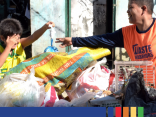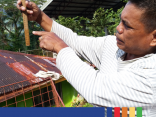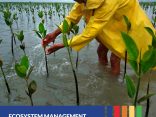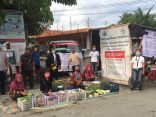by Omer Mejia
In photo: A post-distribution monitoring survey in session. ACCORD ensures that communities are actively involved in the evaluation of and improvement of implemented programs, thereby empowering them to demand better governance from their leaders.
During an informal sharing of some lessons learned from the entire Bohol Earthquake response, the team shared about various kinds of interaction that we experienced with barangay LGUs. Barangay Nahawan's LGU stood out as one of the most supportive and active LGUs that the team worked with. The barangay officials are actively providing suggestions and support in conducting the house damage assessments, shelter materials and cash distributions, and house repairs.
In photo: A post-distribution monitoring survey in session. ACCORD ensures that communities are actively involved in the evaluation of and improvement of implemented programs, thereby empowering them to demand better governance from their leaders.
Arsenio came in the front door of the two storey barangay hall. He is searching for a familiar face in the reception area where we sit casually waiting for respondents to be interviewed. The tall and dark man with a strong physique, extended his arm for a handshake as we introduce ourselves as the team who will conduct interviews for the shelter assistance evaluation. He smiled gently, slightly moving the stitch marks of an inch long scar on his right lower right cheek. Arsenio Degamo is the barangay chairman of the local government of Barangay Nahawan, Clarin, Bohol province.
ACCORD’s team in the Bohol Earthquake Response sought the barangay LGU’s help in identifying respondents for key informant interview session. He came to ensure that we were able to find the people we need for the interviews, even to the extent of fetching them from their houses with his motorcycle. Barangay officials that were in the barangay hall were also equally helpful.
During an informal sharing of some lessons learned from the entire emergency response, the team shared about various kinds of interaction that we experienced with barangay LGUs. Barangay Nahawan LGU stood out as one of the most supportive and active LGUs that the team worked with. The barangay officials are actively providing suggestions and support in conducting the house damage assessments, shelter materials and cash distributions, and house repairs.
There are more examples of outstanding local governments and their officials that have dedicated significant efforts, time and resources in responding to emergencies or reducing disaster risks in their communities. Of course, there will always be examples of local governments that may have not yet realized the importance of implementing an inclusive and participatory DRR. Some leaders may have narrow personal interests. Some may also be overwhelmed by the competing priorities and resources.
Nevertheless, public authorities, in general, are integral and primary actors in disaster risk reduction (DRR) and emergency response (ER). Humanitarian and other civil society organizations (CSO), on the other hand, provide valuable support in building the capacities of communities against disasters. Both are duty-bearers, entrusted with power and resources, to provide the required services from them in upholding the rights of the vulnerable and disaster-affected populations.
Many of the DRR and ER projects engage with the local governments. Usually, in the general logic of the project which starts from the activities (for example, “conduct community risk assessments”) which will then result to the desired outcomes (“communities have increased safety from climate-related hazards”), some good governance practices of LGUs, at least favorable to the project, are usually assumed from the very start of the project.
They are part of the “Assumptions and Risks” on which the whole logical intervention chain hangs (“Local government units are cooperative and willing to conduct disaster risk reduction”). Nevertheless, in all phases of all DRR or ER projects, a certain degree of good governance practice is assumed from local governments. LGUs are involved disaster risk reduction activities such as community risk assessments, trainings, contingency planning, hazard mitigation activities, public awareness, and mainstreaming of DRR into the local development plans. In emergency contexts, LGUs are involved in the selection process to identify direct beneficiaries of emergency assistance, and the facilitation and monitoring of various relief and recovery activities.
DRR and good governance are separate but mutually supportive objectives. Increasing the capacity of local governments and community members in DRR contributes, albeit indirectly, to the practice of good governance. On the hand, DRR provides a concrete context on which good governance principles can be applied. On the other hand, good governance is important, if not necessary, in making DRR successful, together with other development objectives.
One can find in ACCORD’s set of training manuals on DRR that good governance practices are also incorporated in the principles, methods and procedures, such as the use of rights based approach as a framework and lens for DRR, inclusive and participatory methods in risk assessments, and so on. As UNDP puts it, “Governance is the umbrella under which disaster risk reduction takes place.” Thus, it is also important to increase knowledge and capacity for governance. It should also be clear that governance not only involves local governments, but it also equally involves civil society and marginalized citizens.
It follows that governance objectives and its corresponding performance indicators should be carefully monitored and evaluated, both qualitatively and quantitatively. Monitoring and evaluation of DRR projects, on the other hand, focus on the impact, including both outcomes and outputs, of the projects on the beneficiary communities as a whole. However, one would notice that some, if not many, of the governance objectives, which are general in nature, coincide with DRR ones. For example, a governance indicator on awareness of citizens on their rights, such as the following, “Marginalized citizens’ understanding of their own rights and the challenges or vulnerabilities they face,” is done by CSOs, including ACCORD as a strong adherent, in training sessions on rights-based approaches, that recognizes the capacities of vulnerable communities to know, understand and assert their rights for proper and adequate services in reducing their risks against disasters.
There are various and appropriate methods that can be used for monitoring DRR and governance: qualitative interviews and focus group discussions, quantitative surveys, community audits, etc. It is important to remind ourselves that what gets measured gets managed. Understanding the results of our interventions, it is necessary to do monitoring and evaluation of DRR and governance.
This will contribute to a possible eventual institutionalization of good DRR and good governance practices. Of course, there are other fundamental factors in society that affect governance and risks to disasters of communities, such as technological backwardness, great economic disparity, narrow political interests, and cultural subservience. Nonetheless, stories like that of Barangay Chairman Arsenio will not remain as isolated cases of good individuals doing the right things because there will be, at least, a possible influence of the institutionalized DRR and good governance practices to public authorities, civil society, marginalized and other stakeholders.





